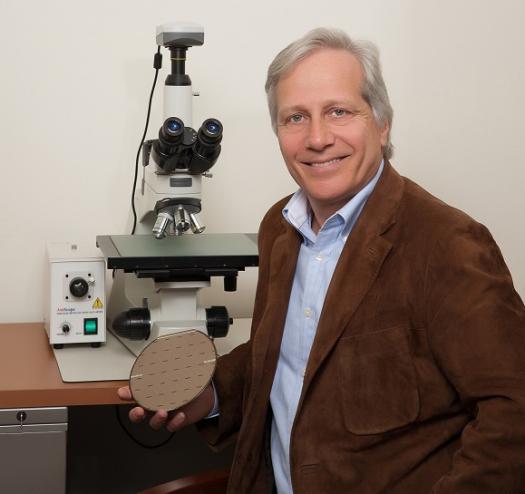EPC: GaN ambition

Intent on flooding power device markets with GaN-on-silicon FETs, Alex Lidow, EPC, talks to Compound Semiconductor about future market opportunities.
For a man that made his name from silicon, Alex Lidow, is now something of a GaN evangelist. On leaving International Rectifier and the world of silicon HEXFETs to launch GaN semiconductor business, EPC, in 2007, he set out to create high performance, cost-effective GaN power devices to replace incumbent silicon transistors.
Seven years on, the company has released some 25 devices - typically manufactured in Taiwan on standard CMOS lines - and industry can expect more.
"We've been delivering GaN transistors for nearly four and a half years and we've staked out this matrix of different products from 30 V all the way up to 200 V," says Lidow. "The costs of our smaller, [lower voltage] devices are actually lower than silicon MOSFETs, though we're not charging less as the performances are very high."
Indeed, Lidow reckons his latest raft of enhanced mode GaN-on-silicon FETs offers half the on-resistance and double the switching speed of previous devices.
"The performance gap between silicon and the last generation of GaN was very large, but we've now increased this gap further; we're very excited," he adds. "We've just delivered six new devices, and we're planning to do another forty soon."
Always-off
In the beginning GaN-on-silicon transistors were depletion-mode types, operating as a normally-on power switch and requiring a negative voltage to switch off. But despite high performance, industry pundits wanted a chip-to-chip replacement for silicon, with always-off operation. And so EPC developed its so-called enhancement-mode GaN transistor with a GaN-on-silicon structure.
As Lidow puts it: "We needed to have enhancement-mode, rather than depletion-mode devices, and now we have this, I have no doubt that GaN will take over the power transistor business, over the next decade, for 600 V applications and less."
But this is where Lidow's take on the future of GaN in power devices gets interesting. While many manufacturers - including EPC - push 600 V GaN-on-silicon devices through qualification, Lidow reckons the real action still lies with lower voltage devices.
According to the EPC chief executive, 600 V devices make up some 25% of the overall power transistor market, while devices rated at 200 V or less, pull in a hefty 75% of the market.
"This lower voltage market is the most performance sensitive and really cares about the switching speed," he says. "Above 600 V, most applications are at 100 kHz and the market becomes focused on cost."
"So our strategy all along has been to aim at the low voltage performance market, and once we get our costs down, go after higher voltage applications," he adds.
In the past, Lidow has forecast that the basic cost of his company's GaN transistor should be less than a silicon MOSFET, with the same on-resistance and voltage, come 2016. But right now, he asserts his company's lower voltage devices have already hit this target, and all products will follow by mid-2015.
"We use standard silicon foundries and produce in volumes; all we have to do is buy the epireactor which is relatively inexpensive, and because our products are self-isolating, we don't have to package the devices," he says. "So GaN-on-silicon can be made cheaper than silicon due to the smaller die and not needing a package. So when you look at it all, the stress on the existing silicon infrastructure is zero."
![]()
Wireless Power Transfer is a key growing market for EPC's GaN-on-silicon transistors [EPC]
But Lidow reckons EPC's price gains will dwindle beyond 600V GaN-on-silicon FETs. He asserts that at much higher blocking voltages - 900V and higher - transistors have typically taken a vertical, rather than lateral structure, in response to higher breakdown voltages and current collapse issues. As such, device manufacturers have grown the device on bulk GaN or bulk SiC, rather than a cheap silicon substrate.
"GaN will only really compete with SiC at these higher voltages when the cost of GaN bulk crystals becomes competitive with SiC bulk crystals, but today GaN crystals are nowhere near that level," highlights Lidow.
And while M/A-COM, for example, has demonstrated high voltage, 1.5 kV GaN-on-silicon FETs, Lidow asserts: "I suspect that SiC will be the dominant growth engine in 900V and above applications for the next decade or so, with GaN being dominant in 600V and below."
So where next for EPC? According to Lidow, the company is still discovering applications for its 30 V to 200 V devices he couldn't have imagined a few years ago. The relatively new markets of envelope tracking in base stations, wireless power and LIDAR applications currently make up around half of his company's business and for him, this is just the beginning.
"The question I ask myself is where does the market go from here," he says. "Will GaN take over analogue ICs? Yes, I think there is a very high probability of that. Can you make digital CMOS with GaN? The answer here is probably yes."
"You'll soon see the very earliest forms of integrated circuit coming from us as well as higher frequency devices," he adds. "We intend to cover the entire $13 billion transistor market."


































